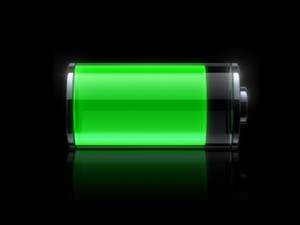 Imagine a laptop battery that lasted for days or weeks instead of just hours. Over the past few years, scientists have been working on a Lithium sulphur graphene battery that could last more than twice as long as a Lithium Ion “Li-ion” battery (the type of battery in most modern day laptops and cell phones). Most Li-ion batteries have between 300 and 500 discharge/charge cycles. The Lithium sulphur graphene batteries are able to go through over 1500 charge cycles without deterioration. Improved battery technology is at an ever increasing demand by car companies like Tesla, as the electric car is becoming closer to an everyday reality of modern life. Experts claim these batteries could enable electric vehicles to travel with a range of more than 300 miles on a single charge. These batteries are still at an early stage in development, and the cost and use of these batteries is still unknown. So for now we are stuck with the Li-ion battery.
Imagine a laptop battery that lasted for days or weeks instead of just hours. Over the past few years, scientists have been working on a Lithium sulphur graphene battery that could last more than twice as long as a Lithium Ion “Li-ion” battery (the type of battery in most modern day laptops and cell phones). Most Li-ion batteries have between 300 and 500 discharge/charge cycles. The Lithium sulphur graphene batteries are able to go through over 1500 charge cycles without deterioration. Improved battery technology is at an ever increasing demand by car companies like Tesla, as the electric car is becoming closer to an everyday reality of modern life. Experts claim these batteries could enable electric vehicles to travel with a range of more than 300 miles on a single charge. These batteries are still at an early stage in development, and the cost and use of these batteries is still unknown. So for now we are stuck with the Li-ion battery.
Probably everyone would like to have a laptop battery that lasts forever. Unfortunately this is not currently possible with modern day Li-ion battery technology. However with some simple care and maitenance you can buy some extra time out of your laptop battery.
NOTICE: These are only recommendations, you should always use the manufacturers recommended care and use for your Li-ion battery.
KEEP IT COOL
Temperature plays a huge role in the lifetime of a laptop batter. Always keep the battery at a normal moderate room temperature. Never allow the battery get too cold. Do not ever charge a laptop battery if the computer reaches a temperature below freezing. Only charge at moderate temperatures. Some batteries accept charge below freezing but at a much-reduced charge current. The battery performance decreases with cold temperature and increases with heat, however shortens life by a factor of two for every 10°C increase above 25–30°C (18°F above 77–86°F). So while the battery will perform better when warm, a battery lives longer when kept at a moderate room temperature.
TURN IT OFF
If possible turn off your laptop while charging. This allows the battery to reach the threshold voltage unhindered and reflects the correct saturation current responsible to terminate the charge. Running the laptop while charging can confuse the charger and the battery will never actually reach the recommended maximum charge.
PULL IT OUT
If you are going to have the laptop plugged into the wall for extended periods of time remove the fully or partially charged battery from the computer and put it into storage. Never remove the battery from the computer if it is not at least partially charged. Be sure to store the battery in a cool dry place. Never store a laptop battery in a refrigerator since this can cause condensation and ruin the battery.
SLIM IT DOWN
Be sure to dim the screen. The screen is the largest drain of the battery in most laptop computers.
Slim-down the processes on the computer. Avoid extraneous programs from running, and stop updates from running. Also avoid processor intensive processes such as movies and games.
Shutoff or remove any hardware that is not being used. Also disconnect any USB hard drives and USB peripherals such as wireless mouse, or a wifi antenna.
PARTIAL CHARGE AND DISCHARGE
Lithium-ion batteries do not actually need to be fully charged. It is actually better to only do a partial charge. It is better not to fully charge the laptop battery, because high voltages stress the battery. Choosing a lower voltage threshold, or eliminating the saturation charge altogether, prolongs battery life however this reduces the runtime. However since most people want maximum runtime, most chargers go for maximum capacity rather than extended service life.
Li-ion should never be discharged too low, and there are several safeguards to prevent this from happening in most laptops. Most laptops cut off when the battery discharges to about 3.0V/cell, stopping the current flow. If the discharge continues to about 2.70V/cell or lower, the laptop battery’s protection circuit puts the battery into a sleep mode. This renders the pack unserviceable and a recharge with most chargers will no longer be possible. To prevent a battery from falling asleep, apply a partial charge before a long storage period.
Battery manufacturers ship batteries with about 40 percent charge. The low charge state reduces aging-related stress while allowing some self-discharge during storage. To minimize the current flow for the protection circuit before the battery is sold, advanced Li-ion packs feature a sleep mode that disables the protection circuit until activated by a brief charge or discharge. Once engaged, the battery remains operational and the on state can no longer be switched back to the standby mode.
Do not recharge lithium-ion if a cell has stayed at or below 1.5V for more than a week. Copper shunts may have formed inside the cells that can lead to a partial or total electrical short. If recharged, the cells might become unstable, causing excessive heat or showing other anomalies. Li-ion packs that have been under stress are more sensitive to mechanical abuse, such as vibration, dropping and exposure to heat.
These are just a few helpful tips you can use to try to extend your laptop battery lifetime. Always follow the manufactures recommended care and use for your Li-ion battery. If you are experiencing issues with your laptop battery or cell phone battery, it may be time to have it checked by a computer repair and laptop repair store. Bring it to South City Computer to have an expert computer service technician diagnose your laptop or cell battery today.
